|
Navam Features
Sankhara in Buddhism
Dr Senarath Tennakoon
There is no proper English equivalent which gives the exact
connotation of this Pali term, and sankhara is a multi significant term
which should be understood according to the context (Narada, 1980). The
Sankrit term is samskara. In Sinhala it is sanskara. Context refers to
the circumstances in which an event occurs. Some English equivalents for
sankhara are volitions, conative and purposive activities, factors
responsible for conscious volitional activity, volitions and intentions,
kammic volitions, conditional things and states, component things, and
mental formations.
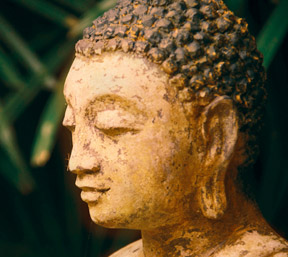
This term refers in particular to volitions and intentions (which may
be morally good, bad or neutral) and the way that these contribute to
the formation of individual patterns of behaviour or traits of
character. Repetition imprints a particular samskara on the psyche and
the imprint is carried over into the next life (Keown, 2003). Mental
formations is a term now generally used to represent the wide meaning of
the word sankhara in the list of Five Aggregates.
Sankhara in other contexts may mean anything conditioned, anything in
the world in which sense, all the Five Aggregates are samkhara. The term
samkhara has different connotations in different contexts.
In the Dhmmapada there are three verses in the section ‘The Path’ (Magga
Vagga) which are significant for the understanding of sankhara. The
first lines in the verses 277,278 and 279 taken together would mean that
all conditioned things all component things are impermanent, sorrowful
and without self. In the third verse (279) the term dhamma is used
instead of sankhara offering a meaning like all dhammas are without
self. Dhamma includes all conditioned things and states as well as the
non-conditioned, the Absolute, Nirvana. Through the insightful realizing
of impermanence, suffering and soullessness one sets in the path of
purification. This is the essence of the remaining sections of these
three verses.
It is a common practice to display a notice or a banner bearing the
slogan ‘aniccavata sankhara’ or ‘vaya dhamma sankhara’ in front of a
house where a person belonging to a Buddhist faith has passed away.
Even in funeral processions, burial places and sites of cremation
such notices and banners are displayed irrespective of the deceased
person's age, gender and socioeconomic position. This slogan could be
interpreted as “all conditional things are impermanent.”
While those who read this notice come to know that some one has died,
they are encouraged to reflect on the three essential characteristics of
all component things – impermanence, suffering and soullessness (anicca,
dukka, anathma).
The Doctrine of Dependent Origination (paticca samuppada) commences
with the statement, dependent on ignorance there are the
volitions/activities (avijja paccaya sankhara) and proceeds ahead with
dependent on volition/activities there is consciousness (sankhara
paccaya vinnanam). Paticca – Samuppada deals with the process of
rebirth.
In this context the sentence avijja paccaya sankhara means that
volitions are conditioned by ignorance (true or false beliefs).
This is the first sense of applying sankhara. In the second sense,
sankhara is used to denote our conative or purposive activities and may
include reflex actions, verbal actions and purposive thinking or
ideation involving impressions, ideas, or concepts associated with
feelings. These are known as kaya sankhara. The third sense of sankhara
denotes all those factors which accompany conscious volitional activity
(Jayatillake, 1971). Ignorance, specific to Buddhism is lack of insight
into the Four Noble Truths.
Any action performed through ignorance becomes kamma with a potential
to react to bring about rebirth and other consequences in accordance
with the kammic law. Only the arahat, who has ended ignorance can
perform volitional acts without forming kamma.
(Mendis, 1985); Ignorance is predominant in immoral activities and
latent in moral activities. Depending on the past conditioning
activities arises relinking or rebirth consciousness (patisandhi-vinnana)
in a subsequent birth (Narada, 1985).
Again sankhara comes to be important in the constituents of the
being. According to Buddhism the human being is a psychophysical unit (namarupa).
The Buddha described a being to be a composite of five groups of
existence or the five aggregates (pancakkandha) and qualified it with
clinging (upadana). As such a man is nothing but a panchaupadanaskandha.
The five groups are the corporeality group (rupakkhanmda) responsible
for the body form feeling group (vedanaskhanda), perception group (sannakkhanda),
mental formation group (sankharakkanda) and the consciousness group (vinnanakkandha).
Taking Buddhism northward
Priyanka Kurugala
Buddhism is a universal concept. The Buddha’s teachings are now
becoming a part and parcel of our lifestyle. This is precisely why the
teachings are spreading its wings across the globe. Buddhism has close
links with Hinduism. According to Ven Nanda Chariya Thera, Tamils have
many reasons to follow Buddhism.
|

Ven Nanda Chariya Thera |
“Time has come to take steps to ordain Tamils in the country to
deliver Dhamma message to Tamil community,” Ven Chariya Thera opines.
Ven Nanda Chariya Thera was born in a village called Paramakudi in
Tamil Nadu in 1952. His grandfather was a businessman in Burma. His
family had many properties including lands in Burma and Tamil Nadu.
“My Father was an atheist. He had met E V Periyar Ramasamy and it was
the turning point. My father, Erode Venkata Ramasamy, was influenced by
the teachings of Dr. Ambethkar and became a follower of the Buddha. Dr
Ambethkar propagated Buddhist Philosophy as the proper way to get inner
peace in mankind. This touched my father’s heart and he influenced me
become a monk. In 1962 I became a monk.”
Ven Nanda Charia now resides at a temple in Los Angeles, USA. He
would have become a doctor if not for his father’s influence.
“There are two kinds of Buddhists in Tamil Nadu. One is ancient
Buddhists, while the other is Ambethkar Buddhists. There are no Tamil
Buddhist Temples. The Japanese are helping us.” The Thera said.
Ven Thera has visited Sri Lanka a number of times to cultivate peace
while proposing new directions to build up ethnic harmony. Mahabodhi
Society, established by Anagarika Dharmapala, has to implement a vast
contribution for Tamil Buddhists in Tamil Nadu, the Thera opines.
“Leaders have to develop equality among each ethnic group as well as
religious groups. The unity among Buddhists, Hindus, Muslims and
Christians is the only way to bring a lasting solution to the ethnic
problem.”
Many people from the time of the Buddha practiced his teachings and
reached ultimate goals. Other parties, who wished to see and enjoy a
peaceful world, dedicated themselves to protect Buddhist philosophy for
the posterity. They built temples and monasteries. Provided many
facilities for Buddhist monks to carry out and teach the Buddhism from
generation to generation.”
Buddhism was a very important gift from India. It was patronized by
Emperor Asoka during the period of King Devanam Piyatissa in Sri Lanka.
With the blessings of government and the opposition parties Ven Nanda
Chariya Thera wants to lead a seven-day peace walk from Colombo to
Jaffna. The aim of his recent visit to Sri Lanka was to discuss the
proposed peace walk to the North with the authorities. “I want to walk
from village to village and talk to poor people and identify what they
need. I want to take Buddhism to the North and build Buddhist Cultural
Centers in the Northern areas,” he said hopefully. I would not encourage
any religious conversions,” he assured. He also said that he is always
ready to be a volunteer helper in Buddhists in Sri Lanka. “I am always
ready to help. I don’t want anything in return,” he stressed.
He further said that all ethnic problems would be solved when
facilitated equally . “All should be given free education, food and
entertainment. Their hearts and brains must be well fed. Peace will only
be there when they all are connected with feelings from the bottom of
their hearts,” he noted.
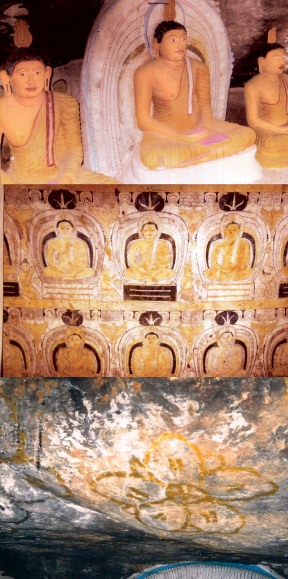 Temple
in a dilapidated status Temple
in a dilapidated status
A.A.L. Dias - Matale District Group Corr.
|
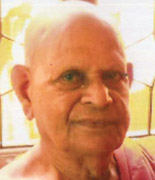
Ven. Millawana Buddharakkitha Thera |
The Cave Shrine Room of Evariyapathaha Raja Maha Viharaya in
Kandapalla-Korale in Matale District which was in dilapidated state for
a long time, was conserved by the Central Cultural Fund.
According to the legends, this temple has a long history over 2,000
years. King Walagambahu was the founder of this place. After that
several provincial leaders had graced to this temple.
So also in ancient times two Stupas which were constructed in the
temple premises, were the road marks of the people.
However, due to the various reasons the religious places were ruined
in the past. After that with the beginning of Kandyan period, the
renaissance of Buddhism was re-started. Under this situation many
temples especially in the upcountry, were renovated. Evariyapathaha Cave
Shrine Room was also renovated in that period. The statues with the wall
and hood pictures in that Shrine Room are similar to Dambulla Rock
Temple.
Therefore, the conservation of Evariyapathaha Cave Shrine Room is
very commendable. The Chief Incumbent of the temple Ven. Millawana
Buddharakkitha Thera said that the Archaeological Department has not
enough strength to preserve the archaeological sites. As the result, the
treasure hunters are searching valuables without any fear.
Evariyapathaha temple was also damaged by them several times. So the
Archaeological Department should pay its attention to this place to
preserve and conserve this historical sacred place for the posterity.
Celebration of the Colombo YMBA Founder’s Day
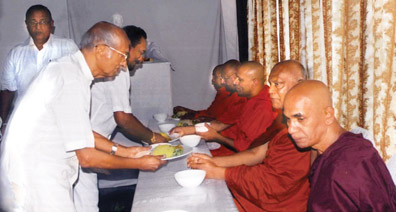
Rajah Kuruppu Vice President, Prasanna Goonatilleke, Governor
and Kusumabandu Samarawickrama of YMBA offering dana to Maha
Sangha at the Commemoration alms giving. |
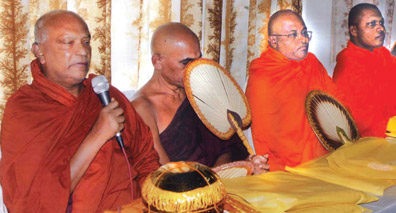
Ven Pelene Mahinda Thera of Mettarama Temple, Colombo
4 delivering anusasana. |
The Colombo YMBA commemorated its Founder's Day on January 19 at the
Head Office, Borella by offering a Sangika Dana with pirikara to twenty
five venerable monks from Gangaramaya, Colombo 02 and Thilakaratnaramaya,
Borella and several monks who have been delivering sermons on Sundays,
Full moon days and conducting meditation sessions at the YMBA.
Ven Gonadeniya Seevalee Thera delivering the Anusasana referred to
the great service rendered to the Association by the past Presidents,
and Officials making the Colombo YMBA the Premier Buddhist Association
in Sri Lanka. He also appreciated various projects being conducted by
the Association for propagation of Buddha Dhamma and promoting Social
and Cultural activities for the benefit of Buddhists in Sri Lanka.
Buddhist awakening in country - Anunayake Thera
Text and pix A. Keerthisinghe - Alawwa Special
Correspondent
There has been a great Buddhist awakening in the country as never
seen before, said Ven. Galagama Attadhassi Anunayake Thera of the
Asgiriya Chapter and also the Viharadhipathi of Mahiyangana Raja Maha
Viharaya.
Ven. Anunayake Thera was speaking at the opening ceremony of new
Awasageya (temple) building constructed at a cost of Rs. 2.6 million at
Sri Sudharmaramaya, Mabopitiya, Alawwa. President Mahinda Rajapaksa’s
leadership too has contributed towards creating this new thinking among
society, the Thera said.
The Prelate further said that the link between the temple and village
has been enhanced to a very great extent mostly due to the increased
Dhamma education and the impetus given to Buddhism and culture by the
Government.
“The people of the country must take this opportunity to send a
message of goodwill to the whole world to overcome international
challenges facing the country, the Thera further added.
Minister Lakshman Yapa Abeywardena visits Matara Bodhi

Investment Promotion Minister Lakshman Yapa Abeywardena with his wife
participated in religious programmes in Matara Maha Bodhi Pooja blessing
him was held at Matara Bodhiya.
Maha Nayaka (Siyam) Rohana Chapter Most Ven. Gombaddala Nandarama
Thera, Ven. Kegalle Ratanasara Thera, Chief Incumbent of Weherahena
Temple and Ven. Godagama Chulalankara Nayaka Thera are also in the
picture.
Picture by A.W. Gunawardhana, Matara Central Corr. |







